| Stromboli
home page |
||
| Geography | Geological Evolution | Eruptive history |
| Volcanic Hazards | References | Web sites |
Stromboli Photo Gallery 1985-1995
Photos were taken by Boris Behncke unless otherwise noted
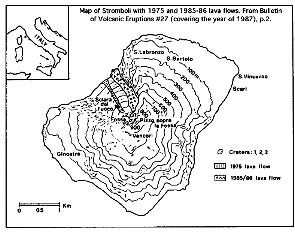 |
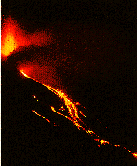 |
|
|
Sketch
map of the island of Stromboli, showing the lava flows of 1975 and
1985-1986 and the active craters (labeled 1, 2 and 3). The map was
prepared by Nappi and Renzulli and was published in the Bulletin
of Volcanic eruptions of the Volcanological Society of Japan, No.
27 (1990)
|
Suggestive
photograph of the December 1985 lava flow running down the Sciara
del Fuoco at an unknown date. Photo by Vincenzo Moreno (Copyright
Edicola Cinefoto Sottile, Lipari).
|
|
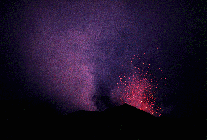 |
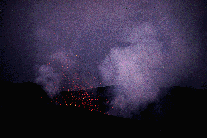 |
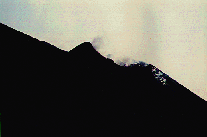 |
|
Eruption
from vent 1 in Crater 1 on the morning of 17 September 1989, during
my first visit to Stromboli. A vapor column is rising from vent
2 in the same crater
|
Vent
2 within Crater 3 is seen here in eruption. Lava fountains were
obliquely projected onto the S rim of the crater. Photo taken on
the morning of 17 September 1989 before sunrise
|
Figure 5-2: Crater 1 seen from the northeast on the afternoon of 1 April 1990. A small conelet, about 20 m high, is visible at vent area 1/3 |
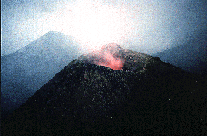 |
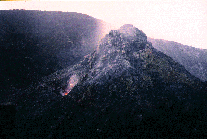 |
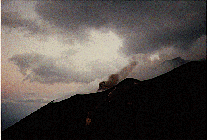 |
|
Spatter
cone at vent area 1/2 (center of Crater 1) on the evening of 1 April
1990, viewed from the southeastern rim of the crater, about 30-50
m distant. The vent of this cone showed a suggestive glow but did
not erupt
|
Conelet at vent location 1/3, with eccentrically placed incandescent vent at its southern base (left) . No distinct vent is recognizable at the summit of this conelet |
Stromboli's
craters seen from the "Fossetta" area, to the south. This compares
to photos taken around the turn of the century (see the images of
Stromboli
before 1930), showing significant upward growth of the
crater terrace during the past 100 years. This photo was taken during
a small ash eruption from vent 2 of Crater 3 on the afternoon of
7 November 1990
|
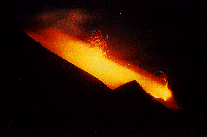 |
 |
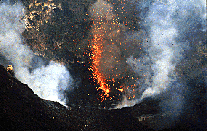 |
|
Simultaneous
eruption from three vents shortly after midnight on 8 November 1990.
The left fountain comes from vent 3/2 while the right ones rise
above unidentified vents within Crater 1. Activity of this kind
was going on for tens of minutes without interruptions but was less
continuous and intense than that observed on 21-22 August 1994.
View is from north
|
Panoramic view of the crater terrace seen from Pizzo sopra la Fossa on 29 August 1991. Note filling of craters with pyroclastics and small cone at vent area 3/1 (in center of image) | Small explosion from vent 2 within Crater 3 on the morning of 29 August 1991, observed from SE rim of the same crater, during my visit together with Jon Dehn. The fountain is rising from several very small openings in the crater floor, or shoots out between scoria and bombs covering the genuine vent. Fragmentation and/or abrasion of the crater-filling pyroclastics forms a diffuse plume of brown ash around the lava fountain. The height of the fountain is 30-50 m. During our stay we observed about 10 eruptions of this kind that never exceeded the magnitude of the one shown here. Photo by Jon Dehn |
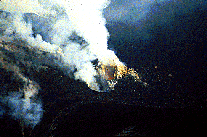 |
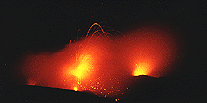 |
|
| Vent 1 within Crater 3 had changed considerably during our August 1991 visit from what it was like in 1990. The small cone was probably built during the intense October-November 1990 activity. The cone had two eccentric vents, illuminated by the glow of magma at shallow depth. No spattering took place during our visit. Photo by Jon Dehn | A rare view of an eruption from Crater 2, captured by Marco Fulle at 2200 on 29 May 1992. Spatter from Crater 2 are flung obliquely onto the S rim of Crater 1. At the same time, continuous low fountaining occurred from vent area 1/3 (right). Vents 1 and 2 in Crater 3 display only persistent glow. The exposure time is 10 minutes | Another shot by Marco Fulle, taken at about 0400 on 4 June 1992. Minor obliquely projected eruptions occur still from Crater 2 and vent 3 in Crater 1 ejects taller fountains. Intense glow persists from vents 1 and 2 of Crater 3 |
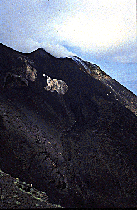 |
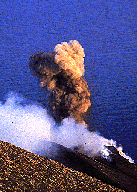 |
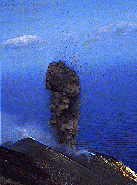 |
|
Photos taken by Jon Dehn in June 1993. Left: Crater 1 and N slope of the Sciara del Fuoco about one month after the brief effusive episodes of mid-May 1993. The new flow lobes show clearly on the slope below Crater 1, reaching a length of max 150 m. Nine months later, during my first summit visit since August 1991, the flows were completely buried under material ejected by the violent October 1993 explosions. Note the small cones in Crater 1 Center: Early morning explosion from central vent in Crater 1, June 1993. The large version of this photo shows large glowing bombs within and beyond the ash column. Ash eruptions from Crater 1 are much less common than those from Crater 3 Right: Powerful bomb and ash explosion from the same vent, later that same morning. Numerous bombs are rising high above the ash column |
||
 |
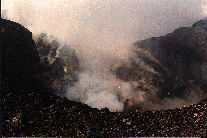 |
|
| Close-up of eruptive activity within Crater 1 on the morning (0400) of 8 June 1993 when Stromboli was in a period of unusually intense, though already declining, activity. A large intracrater cone with a broad summit crater and two adjacent vents is visible to the left of the fountain that comes from a vent in the N part of the crater (1/1). Photo by Marco Fulle | Mosaic of two photos taken by Marco Fulle taken at around 0600 on 8 June 1993. A diffuse lava fountain rises from vent 1/1 (far right) with simultanous vapor emission from the cone at neighboring vent 1/2. A glowing spot is visible at the base of a small spatter cone at vent 3/1, and a small ash plume rises from vent 3/2. The rugged area on the extreme right of the crater area is the source vent of the May 1993 lava flows | During the visit to the craters on 12 March 1994, the most intense activity took place deep within a pit at vent location 3/1. This pit is seen here during daylight from the southern rim of Crater 1. A few bombs can be distinguished in the lower central part of the pit, indicative of near continuous spattering at the pit's floor |
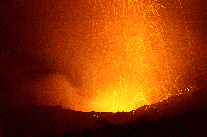 |
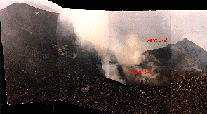 |
|
| The same vent (of the previous photo) seen from the NE rim of Crater 3 on the evening of 10 March 1994. The lava fountain visible here was about 50 m high; others rose to about 120 m height. Acid vapors had destroyed my wide-angle zoom lens during the preceding hours so I had to use a 50 mm lens, failing to capture the full fountain | Photomosaic of Crater 3, seen from S rim of Crater 1 on the morning of 12 March 1994. Locations of vents 3-1 and 3-2 are indicated. Note high SE rim of crater (at left) and large blocks of the October 1993 explosions lying around everywhere | Fifteen minutes exposure by Marco Fulle of Stromboli erupting from four vents at about 0200 on 17 June 1994. A vertical fountain shoots up from vent 1/2 while adjacent vent 1/1 (to the right) obliquely projects spatter onto the S and SE sides of Crater 1. Eruptions occur also from vents 1 and 2 in Crater 3 (left). The volcano enters a period of strongly increased activity. No cones are yet visible, pointing to rapid growth during the following two months (see the photos below) |
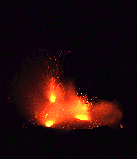 |
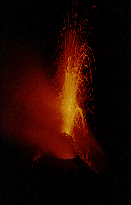 |
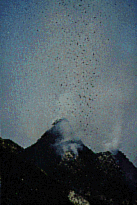 |
| Several vents erupting simultaneously in Crater 1 during the first hours of 22 August 1994, seen from Pizzo sopra la Fossa. Eruptions occur from the summit of the large central cone (vent location 1/2) and from a broader bocca on a lower cone at 1/1. Several smaller incandescent vents can be seen around the two fountaining ones. Height of fountains is about 50 m in this image |
Activity of Crater 1 on 22 August 1994. Left: Spectacular continuous lava fountaining occurred from the new central cone of Crater 1 shortly after midnight on 22 August 1994, often lasting up to 90 minutes. Similar activity occurred from the broad glowing vent visible at the front base of the cone which was acting in a completely independent manner (i.e. both vents had individual periods of intensified fountaining or erratic expolsive behavior) Right: Explosion from the broad vent just below the central cone on the forenoon of 22 August 1994. No activity is occurring from the summit vent of the cone in that moment, but erratic bursts of spatter were occurring in the same period (i.e. after 1000 h) |
|
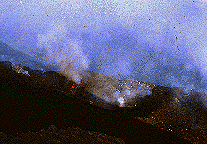 |
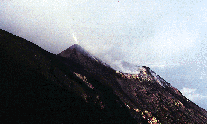 |
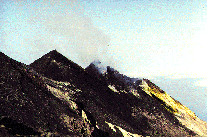 |
| Eruption from vent 2 in Crater 3 at dawn, 22 August 1994. Broad lava fountains rise from three closely spaced vents in the center of the soutwestern depression of Crater 3. This eruption did not reach heights like others did, in the night before. Note shallowing of the craters | Crater 1 seen from the northeast on the morning of 12 March 1994. The slope below the crater is covered with debris from the October 1993 explosions, and no traces of the May 1993 lava flows are visible. Note absence of cones within the crater | Crater 1 seen from the northeast on the forenoon of 22 August 1994. A spectacular cluster of cones has grown since the last visit, and a small, very recent lava tongue (indicated by an arrow) extends down the N flank below the lowest point of the crater rim. New dark tephra covers the areas around the crater |
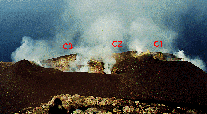 |
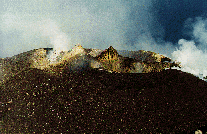 |
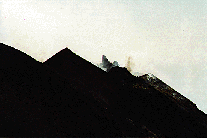 |
| Panoramic v iew of Stromboli's craters from the Pizzo sopra la Fossa on the forenoon of 20 April 1995. Half of the cone in center of Crater 1 has been blasted away by the strong 5 March 1995 explosion, exposing its conduit | Detail of Crater 1 with the central August 1994 spatter cone (vent area 1/2) bisected by the 5 March 1995 explosion, the explosion pit before it and the "Gemelli" cones to the left. Photo taken 20 April 1995 from Pizzo sopra la Fossa | Profile view of Crater 1 from NE on 20 April 1995. The half-destroyed August 1994 cone forms the prominent pinnacle in the center, showing a vertical wall facing the 5 March 1995 explosion pit |
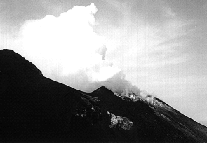 |
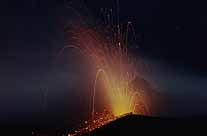 |
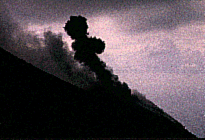 |
| Crater 1 seen from the northeast on 30 April 1995. Strong steam emission hides features within the crater. Pizzo sopra la Fossa is to the left. The photo was supplied by Richard Pichl, University of Prague | Close-up of lava fountaining from vent area 2 within Crater 1 on 20 June 1995, at about 0400. The vent lies at the SE base of what remains of the 1994 central cone (visible in the right background). No eruptions of solid material had occurred from this vent during the April 1995 visit. To the left of the fountain, the steaming northern cone of the "Gemelli" is faintly visible. Photo supplied by Marco Fulle | Small ash explosion from Crater 1 on the afternoon of 28 September 1995, seen from the NE. This is probably the most impressive photo that I took during the second 1995 visit to Stromboli (18-19 September 1995) since weather conditions were quite unfavorable, preventing good visibility. Additionally, the activity was extremely weak on that day, not representative of that period |
Copyright © Boris Behncke, "Italy's Volcanoes: The Cradle of Volcanology"
